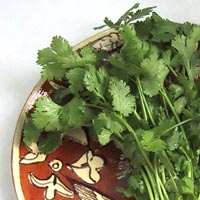Gluten Free
What does following a gluten-free diet mean? That you're embarking on an easy diet with a wide range of health-promoting effects. Instead of dwelling on what you’re giving up, consider that you’re going to enjoy a whole new world of delicious food options to meet your special dietary needs. You’ll be eating seasonally, choosing more fresh fruits and vegetables, focusing on meats, seafood, poultry, legumes, lentils, corn, and rice, and discovering fascinating ancient grains such as quinoa, amaranth, and millet. You’ll be able to eat potatoes, eggs, most cheeses, even chocolate (!)—and enjoy them without guilt because you’ll be taking good care of your body. In fact, you’ll probably end up eating—and feeling—better than ever!
Visit this page for more information about living Gluten Free
---
We carry a large variety of gluten free items, the brands listed below represent just some of the offerings we carry















More Diets
Coriander

Preparation, Uses, & Tips
All types of coriander—whole, ground, and the leaves—have many uses. Whole coriander seeds are used in pickling and for special drinks, such as mulled wine, whereas ground coriander is often used in baked goods (especially Scandinavian), curry blends, and soups. Ground coriander is a major component of garam masala, a basic spice mixture used in Indian and Pakistani cuisine.
Ground coriander quickly loses its pleasantly sweet taste and smell. When a recipe calls for ground coriander, it’s best to grind whole seeds just prior to use. To heighten the flavor of coriander, first toast the whole or ground seeds.
Cilantro leaves are widely used in the cuisines of India, Mexico, the Orient, and the Caribbean. The fresh herb may be used like parsley, both as a garnish and a flavoring. Fresh coriander is what gives many fresh salsas and ethnic dishes their zing. Use it sparingly with delicate ingredients, or its flavor overpowers. In strongly flavored sauces and salsas, it can be used in larger quantities. For best flavor, the leaves should not be overcooked.
Despite their differences, all forms of coriander blend well with garlic, cumin, oregano, onions, ginger, and chile peppers.
Copyright © 2025 TraceGains, Inc. All rights reserved.
Learn more about TraceGains, the company.
The information presented in the Food Guide is for informational purposes only and was created by a team of US–registered dietitians and food experts. Consult your doctor, practitioner, and/or pharmacist for any health problem and before using any supplements, making dietary changes, or before making any changes in prescribed medications. Information expires December 2025.











